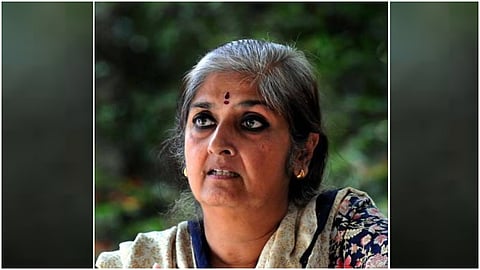

You name a heritage structure in Hyderabad, she has its history on the tip of her tongue. You go to a heritage event in the city, she is there, actively speaking about the occasion and patiently clarifying doubts. Anuradha Reddy, INTACH (Indian National Trust for Art and Cultural Heritage) convenor for the Hyderabad chapter, has been a history enthusiast since her childhood. For more than five decades, she has been travelling extensively and actively exploring heritage sites within and outside India.
TNM caught up with Anuradha even as she is busy amid field work in Hyderabad. Here are some excerpts:
We all grow up in the midst of heritage, whether it’s built heritage or other forms of cultural heritage like art, music and dance. I grew up with grandmothers from both paternal and maternal sides. Ours was a household that consisted of many residents, and also visitors who brought with them different cultures and stories. We shared the lives of so many people through these experiences. Everyone should be aware that, directly or indirectly, they are also part of heritage.
My exposure to travel was also more because of my father, Chilam Sree Ram Bhoopal, who was in the Hyderabad civil service, which became IAS after 1966. My mother, Sneha Latha Bhoopal, had a wide interest in culture, history, photography, badminton, which also exposed me to wide travel within India. This was the base for how my interest in our culture developed.
In the 1970s and 80s, I began to see the lack of awareness and interest in the protection of our built heritage. I became very concerned and started to look for spaces that were working in heritage protection. In 1984, after INTACH was formed at the India level, Hyderabad was the second chapter to open in the country. I immediately joined, because I found that there were interesting groups that could work together in the protection of our heritage and culture. I’m also the former president of another group called SPEQL (Society for Preservation of Environment and Quality of Life), which works with natural and built heritage and environmental protection.
We launched the Zilla Khazana programme to promote participation from local people, especially in colleges and high schools, so that students, teachers, lecturers and common citizens can learn about their surroundings and share. Simultaneously, documentation would also be built up zilla (district) wise. It is the citizens who normally should be the protectors of heritage.
Shared heritage can be between anyone – between states like Andhra and Telangana, where there are Kakatiya influences. It can be between Karnataka and Telangana, because Kakatiya monuments have common features with the Hoysala monuments seen in present day Karnataka. It can be between Delhi and Hyderabad, both in the Mughal period in the later Qutb Shahi period and the other Deccan kingdoms. We also have a shared heritage with the architecture of Iran and other Middle Eastern countries.
Further, eastwards we share heritage with Nepal, Bhutan, Japan, China, Vietnam, Cambodia, Thailand, Indonesia, etc., which followed the Hindu architectural styles and culture, for example Angkor Wat in Cambodia and the Champa kingdom of Vietnam.
On visits to Japan and China, I saw huge influences of India in their culture and sculpture. When I visited Mexico, I found similarities between the Mayan culture and that of south India. All these need to be explored further.
It’s the loss of public property, public funds, and public identity. A heritage structure is formed from the history of the public of another period. Heritage structures are examples of technology, craft of the period. In many cases, neither the material nor the skills can be duplicated.
Born and brought up in Hyderabad state, which is a confluence of many cultures from across India and the world, I believe language also becomes a rich and valuable cultural resource.
Back then, Hyderabad state had four official state languages – Telugu, Marathi, Kannada and Urdu with English as the official working language. This came about because Hyderabad consisted of citizens from different regions who spoke these languages. It gave them a sense of identity and belonging. I learnt French also in my childhood. I took up German later on, as I found myself lost in historical places if one doesn’t know the language. To connect with the country’s history, I learnt German in Max Mueller Bhavan (today’s Goethe-Zentrum Hyderabad).
Coming to the Hindi part, I’m not looking at it as an imposition, but it’s an advantage. Being in the Deccan, we’re able to understand, contribute and share with other Hindi speaking regions of the country. Every language is an additional asset and a link to an additional culture.
We from the INTACH team inspected the hospital in 2015 and again in 2019. During the recent torrential rains in Hyderabad, there was not a single drop of water inside the heritage building. The structure speaks for itself, it needs our protection.
There are many aspects to getting a world heritage tag. It involves not only agencies such as the Archaeological Survey of India (ASI) and State archaeology, but it involves a huge commitment from the state government as well.
ASI is doing the best it can, given the circumstances, because encroachments have become a huge threat to monuments. The role of the police, local municipalities, panchayats and the revenue department is large because it is they who have to support ASI. ASI’s only role is to raise complaints, everything else lies with the rest of the agencies. The Collector of each district also has an enormous role to play in the protection of heritage sites.
No comment.